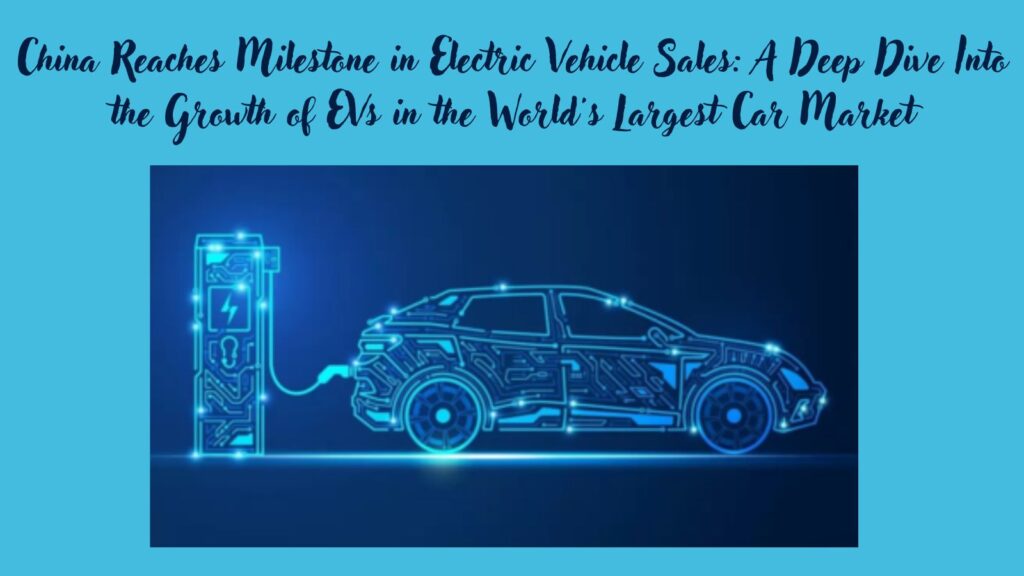China Reaches Milestone in Electric Vehicle Sales
China hit a big milestone in electric vehicle (EV) sales. In August 2024, it sold over one million EVs. This is a 33% increase from last year. This achievement shows that China leads the world in electric vehicle adoption. It also highlights the rise of new energy vehicles (NEVs) in the country’s car market.
EV sales are rising, but China’s passenger vehicle market faces challenges. Overall car sales dropped by 1.1% in August. Even with this drop, EVs are still strong. This is thanks to strong government support and rising consumer demand for green transport options.
In this analysis, we’ll look at China’s huge success in EV sales. We’ll also cover trends in the automotive market and factors that shape the global electric vehicle market. We’ll look at how Chinese government subsidies help speed up the EV transition. We’ll also discuss the challenges Europe and other regions face in adopting EVs.

China’s EV Milestone: A Major Step Forward
In August 2024, China sold over one million EVs in just one month. This is a big milestone that shows China’s strong drive to lead the global electric vehicle market. This shows a 33% growth from last year. It’s part of China’s strong shift to electric mobility.
Data to back up China’s dominance:
- EVs now account for 53.5% of total car sales in China. That means more than half of all passenger vehicles sold in the country are either fully electric or plug-in hybrids.
- The growth rate for New Energy Vehicles (NEVs), which includes all-electric and plug-in hybrid vehicles, has surged by 43.2% year-to-date. This jump shows the growing shift from gas-powered cars to cleaner, sustainable options.
Real-time Example: A key reason for this success is China’s leading EV makers, like BYD, NIO, and XPeng. They have excelled in production and innovation. For instance, BYD, China’s largest EV maker, reported record sales, with 1.9 million EVs sold in 2023 alone. In August 2024, the company sold over 200,000 electric cars, further solidifying its position as a leader in the EV space.
Decline in Overall Car Sales: Is It a Sign of Worsening Market Conditions?
While the growth in EV sales is impressive, it comes amid a more troubling trend in China’s overall passenger vehicle market. According to the China Passenger Car Association (CPCA), overall car sales in China dropped by 1.1% in August 2024, totaling 1.92 million vehicles. This decline shows a bigger drop in consumer confidence. Economic uncertainties and changing market dynamics are driving this trend.
The challenges facing the broader car market in China have been compounded by several factors:
- Economic Uncertainty: Economic pressures, like a slow pandemic recovery and worries about China’s real estate, have cut consumer spending on new cars.
- Growing Competition: Electric vehicles are on the rise. China is also cutting emissions. This forces traditional automakers to adapt quickly. Also, global car makers are seeing more competition from Chinese brands.
However, despite these challenges, EVs have proven resilient. Consumers are shifting to cleaner, cost-efficient vehicles. This growth shows that even during economic uncertainty, they still prefer these options. This shift is largely driven by both consumer preferences and governmental incentives.
Impact of Subsidies on NEV Sales: The Role of Government Support
China’s success in the EV market can be attributed to a combination of government policy, subsidies, and consumer incentives. The Chinese government is pushing for more electric vehicles. They give money to both makers and buyers to help.
Key subsidies and incentives driving NEV growth:
- Vehicle Trade-In Subsidies: Buyers can get up to 20,000 yuan (~$2,800) when they trade in older, polluting vehicles. This helps them buy a new electric or hybrid vehicle.
- Smaller Car Subsidies: For those looking to buy smaller EVs, a 15,000 yuan (~$2,100) subsidy is available to encourage adoption.
- Manufacturers get help from the government through subsidies. These incentives boost domestic EV production. They include funding for research and development and support for electric car manufacturing.
These subsidies lower costs for consumers. They also cut carbon emissions by taking older, less efficient vehicles off the road. As a result, consumers are more willing to make the jump to electric vehicles, further boosting the overall adoption rate.
Fun Fact:
- In 2019, China accounted for over 50% of the world’s total EV sales. The 2024 sales surge will boost China’s dominance. This growth makes China a key player in global sustainability goals.
Global EV Market Trends: The Road Ahead
While China’s EV market continues to thrive, global EV adoption is also on the rise. In 2024, the global EV market saw 9.8 million EVs sold, representing a 20% increase year-to-date as of August. The demand for electric vehicles is still strong. However, different regions show various growth patterns.
Regional Insights:
- United States & Canada: The North American EV market is growing. Sales rose by 9%, even with challenges like high prices and limited infrastructure.
- Europe: Unlike China, Europe has seen a 4% decline in EV sales. This is the first drop in Europe’s EV market, which has historically been a strong adopter of electric vehicles. Germany stopped its subsidies. Also, the EU placed restrictions on Chinese-made EVs. This caused prices to rise. Now, there are fewer affordable options for consumers.
EVs face challenges, but the outlook is bright. Experts say global sales will keep rising as battery costs drop and infrastructure gets better
Challenges in the European Market: What’s Driving the Decline?
Europe, which has been a key player in the global EV transition, is facing its own set of challenges that have impacted its growth trajectory.
- Germany’s End of Subsidies: In 2023, Germany ended its EV subsidies that had previously driven strong adoption. The policy change has led to reduced consumer demand and a slowdown in EV sales across Europe.
- Bans on Chinese EVs: The European Union has restricted some Chinese electric vehicles. They worry these models could hurt local manufacturers. These bans make it tough for European consumers to find affordable, high-quality EVs. Chinese automakers like BYD lead the global market, but these restrictions limit access.
As a result, Europe is facing a 4% drop in EV sales, a concerning development after years of rapid growth in the region.
Future Outlook: A Bright Future for EVs in China
Despite the challenges in the global market, China’s EV market remains poised for continued growth. Experts like Charles Lester from Rho Motion are hopeful for the future. They predict that monthly EV sales will hit over one million units multiple times this year. Consumer demand usually rises in the second half of the year, which supports this expectation.
Why the future is bright for China:
- China’s government strongly supports clean energy vehicles. They plan to phase out gasoline-powered cars soon.
- Technological Advancements: Chinese automakers continue to innovate, producing high-quality EVs at competitive prices.
- Expanding Charging Infrastructure: The Chinese government is investing a lot in EV charging networks. This will help more people adopt electric vehicles.
Real-Time Example: Chinese automaker BYD is breaking new ground with its Blade Battery. This technology is safer and lasts longer than regular lithium-ion batteries. This technological breakthrough is expected to further drive the adoption of electric vehicles in China and beyond.
Frequently Asked Questions (FAQs)
China’s EV market has thrived. Government subsidies helped a lot. Strong local companies, like BYD, also played a big role. Plus, more people want cleaner and efficient vehicles. Additionally, the country’s focus on reducing emissions has driven the adoption of electric vehicles.
Yes, government subsidies and competition among Chinese automakers have lowered EV costs. This makes them more affordable for consumers.
China’s EV market is growing fast. In contrast, Europe saw a 4% drop in EV sales in 2024. This decline is mainly because of subsidy cuts in Germany and EU rules on Chinese EVs. However, China remains the global leader in EV sales.
Experts are optimistic. They predict that China’s EV sales will keep growing. This growth is driven by rising demand and better infrastructure.
EV buyers in China enjoy government subsidies. They also save on long-term costs. Plus, they help the environment by driving clean energy vehicles.
Transmission Issues Plague 2025 Toyota Tacoma Models: What You Need to Know
Conclusion: China Leads the Charge in the Global EV Revolution
China has become the top player in the electric vehicle market. In August 2024, it sold one million EVs. China’s sales grew by 33% from last year. This growth helps it lead the global EV market. Government support and subsidies boost this trend. Also, rising demand for sustainable transportation plays a key role.
China continues to invest in EV infrastructure, even with global market challenges, particularly in Europe. This focus on innovation will strengthen its leadership in the EV sector for years to come. China is playing a big role in the move toward sustainable transportation. Its impact on the future of mobility is clear.






